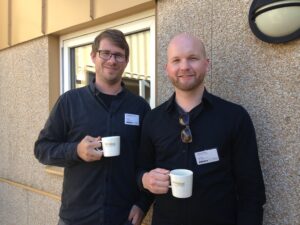
Acoustics is a broad subject and as a researcher, it can be easy to forget to occasionally lift the head, straighten the back, breathe and take in the surroundings.
The EU-funded iCARE project (Improving Children’s Auditory Rehabilitation) aims to promote inter-disciplinary research to benefit hard of hearing children and has been running for three years now. In order to achieve this “cross-fertilisation”, the project arranges winter and summer schools, provides researchers with in-residence programs at other universities as well as secondments with industry partners. We were lucky enough to have two of the researchers, Florian Pausch from RWTH Aachen University and Douglas MacCutcheon from University in Gävle, come join us here at Ecophon to show them a bit more about our favourite type of acoustics. Here are their accounts of leaving the research community and entering… our fascinating world of room acoustics.
Optimal conditions for learning – Douglas MacCutcheon

During May 2017, myself and my academic colleague Florian were given the privilege of spending a week at Ecophon as part of an industrial placement for the iCARE project. The iCARE project aims to accomplish a high level of auditory rehabilitation for children with hearing problems and has mobilised a team of interdisciplinary researchers at various stages of their careers in order to achieve this vision. The aim of this placement was to create a bridge between academic theory and industrial practices.
Achieving sound conditions needed to get the most from the education
As Florian (engineering/acoustics) and I (environmental psychology) are researchers of the impact of classroom acoustics on children’s cognitive and language development in different learning environments, we were interested to find out as much as possible about the sort of materials that Ecophon uses to achieve the sort of sound conditions that children need in order to get the most out of their education. We were given an extensive tour and even taken to a school currently installing Ecophon products so we could see this in action and speak to the knowledgeable technicians that install these products. We found that Ecophon approaches the problem of optimising classroom acoustics from a variety of levels, sustainably sourcing materials and working closely with academia so as to not lose sight of the end-user or the ecosystem.
Bringing the forest into the classroom
It was very stimulating to discuss research ideas and acoustics with their research and development team, who are extremely motivated to find out what the optimal acoustic conditions are for learning. Their enthusiasm for recreating the original environment under which children have learned – namely, the forest – by bringing forest acoustic conditions to the classroom, was a fascinating concept and one I look forward to hearing more about in the years to come.
How to fix the leak in acoustic communication – Florian Pausch
Reverberation time, speech clarity, distance of comfort, #?=$%§ – What do these technical terms refer to?
What is the optimum acoustics for a specific room type based on its purpose and related activities?
Although the answers to these questions might not be completely straightforward, there certainly is a way to explain things effectively. Ecophon provides an extensive implementation chain when it comes to improving the acoustics and thus the work, education or healthcare environment. Important steps in this chain include not only educating involved parties to make them aware of good room acoustics by highlighting its impact on several human-related factors but also tailoring solutions based on the customer’s needs and activity-based design trade-offs to finally create a high level of acoustic comfort.
Getting in touch with key stakeholders
During my industrial secondment at Ecophon’s HQ in Sweden, I was provided with a wide-ranging insight into room acoustics in offices, schools and healthcare as well as the company philosophy. A presentation about current project and research results gave me the opportunity to reach out to a group of educational experts, addressing a highly relevant group for the iCARE project which was really valuable.
Academic research as an important business driver
One thing that surprised me was Ecophon’s link to academic research which shows the company’s interest in handling room acoustics through a holistic approach. For example, by integrating results from questionnaire-based studies that show the impact of degraded room acoustics on cognitive stress and professional efficiency. I also enjoyed the opportunity to gain some practical insights during on-site visits of construction sites and through hands-on acoustical measurements.
This industrial secondment widened my knowledge about acoustic solutions and room acoustics in a more interdisciplinary sense by incorporating different research areas, concept development and sustainability and I take this with me into future projects.
More on Florian and his research on real-time auralisation system for people with hearing loss.
For more information on the iCARE project, please contact Carsten Svensson.

